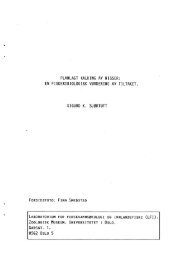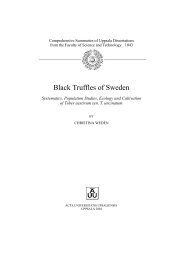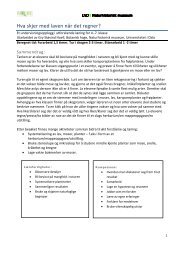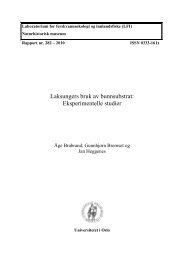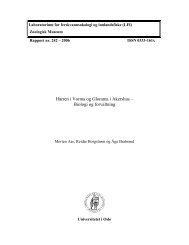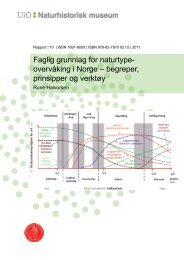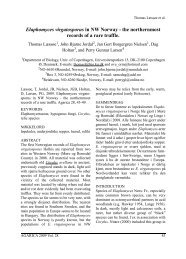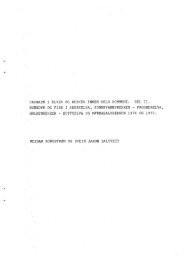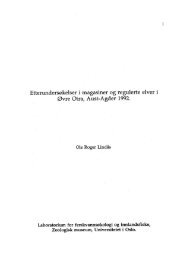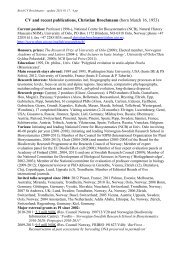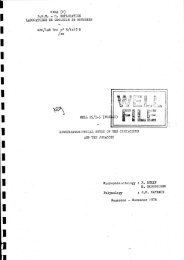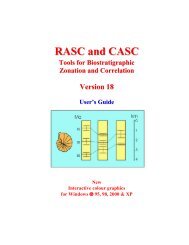Truffle trouble: what happened to the Tuberales?
Truffle trouble: what happened to the Tuberales?
Truffle trouble: what happened to the Tuberales?
- TAGS
- truffle
- www.nhm.uio.no
You also want an ePaper? Increase the reach of your titles
YUMPU automatically turns print PDFs into web optimized ePapers that Google loves.
1088 T. Læssøe, K. Hansen<br />
Kimbrough et al. (1996) studied <strong>the</strong> ultrastructure of <strong>the</strong> type<br />
species. Trappe (1979) included ano<strong>the</strong>r monotypic genus, Phyma<strong>to</strong>myces,<br />
in Barssia, but as <strong>the</strong> type has been lost, this<br />
Japanese taxon should be re-investigated. Barssia ascomata<br />
have a smoo<strong>the</strong>r surface compared <strong>to</strong> species of Balsamia.<br />
Molecular results indicate a very close relationship between<br />
Barssia and Balsamia, so that it may be a sound move <strong>to</strong><br />
synonymize <strong>the</strong>se genera, but more taxa, including <strong>the</strong> type<br />
of Balsamia, should be sampled before such a decision is made.<br />
Helvella L. 1753: Fr.<br />
Helvella astieri Korf & Donadini (Fig 6F) (Korf 1973b) is <strong>the</strong><br />
only known truffle within <strong>the</strong> genus. No molecular data are<br />
available for H. astieri, but its placement in Helvella is convincing<br />
on morphological grounds. It has closed semi-hypogeous<br />
fruit bodies and apparently passive spore dispersal, but an<br />
operculum is still present. The species is very rarely recorded,<br />
but is known from France and Denmark (Hansen & Knudsen<br />
2000). The similarity of H. astieri and species of Hydnotrya<br />
was used in placing Hydnotrya in <strong>the</strong> Helvellaceae (Trappe<br />
1979; Pegler et al. 1993). Trappe (1979): ‘Korf in effect emended<br />
<strong>the</strong> family (Helvellaceae) <strong>to</strong> include astipitate, infolded and<br />
chambered ascomata by <strong>the</strong> description of Helvella astieri<br />
Korf & Donadini. This species is essentially a Hydnotrya with<br />
operculate asci and hyaline spores’. This view was strongly<br />
opposed by Donadini (1986a), as he found spores, paraphyses<br />
and excipulum exactly as in Helvella.<br />
Insufficient data [placed here in Eriksson (2006a)]:<br />
Picoa Vittad. 1831<br />
Type: Picoa juniperi.<br />
This genus was placed in <strong>the</strong> Balsamicaeae by e.g. Trappe<br />
(1979) and likewise in Montecchi & Sarasini (2000). Some species<br />
have asci arranged in a clear palisade, whereas in o<strong>the</strong>rs<br />
<strong>the</strong> asci are more dispersed. The genus can be difficult <strong>to</strong> differentiate<br />
from Balsamia based on <strong>the</strong> characters employed<br />
e.g. by Montecchi & Sarasini (2000). Preliminary LSU rDNA sequence<br />
data of P. juniperi, suggest it is more closely related <strong>to</strong><br />
Otidea (unpublished data in O’Donnell et al. 1997) than <strong>to</strong> <strong>the</strong><br />
taxa in clade B (as sampled by O’Donnell et al. 1997).<br />
Tuberaceae Dumort. 1822<br />
Only hypogeous taxa cluster alongside <strong>the</strong> likewise hypogeous<br />
genus Tuber. Ascomata produced by <strong>the</strong> Dingleya–<br />
Choiromyces lineage show a persistent hymenium (chambered<br />
<strong>to</strong> completely compressed ptycho<strong>the</strong>cia), whereas ascomata<br />
produced by Tuber spp. have lost <strong>the</strong> hymenium (stereo<strong>the</strong>cia).<br />
Tuber is <strong>the</strong> most speciose genus of ascomyce<strong>to</strong>us truffles,<br />
and it is known from many areas around <strong>the</strong> world,<br />
including North America, Central America, Europe, and Asia,<br />
but apparently not from subsaharan Africa and South America.<br />
It has been introduced <strong>to</strong> Australia (Bougher & Lebel<br />
2001). Dingleya, Reddellomyces, and Labyrinthomyces clearly<br />
have a centre of diversity in Australia and New Zealand.<br />
Choiromyces Vittad. 1831 (syn. e.g. Piersonia) (Fig 6B)<br />
Type: Choiromyces meandriformis (syn. C.venosus)<br />
Although often placed in <strong>the</strong> Helvellaceae (e.g. in Pegler et al.<br />
1993) current molecular phylogenies place <strong>the</strong> type species as<br />
a sister <strong>to</strong> Tuber, making it possible <strong>to</strong> include it in <strong>the</strong> Tuberaceae<br />
(O’Donnell et al. 1997). Gilkey (1955) and also Korf<br />
(1973a) suggested this placement, whereas Hawker (1954)<br />
and o<strong>the</strong>rs (e.g. Trappe 1979) placed <strong>the</strong> genus in <strong>the</strong> Terfeziaceae<br />
based on structural studies. Zhang & Minter (1989a) studied<br />
C. gangliformis (considered by some, e.g. Montecchi &<br />
Sarasini (2000), as a possible synonym of C. meandriformis) in<br />
detail and found four nuclei in <strong>the</strong> spores, which could<br />
indicate <strong>the</strong> Helvellaceae. However, 4-nucleate spores are also<br />
commonly found in Tuber. Zhang & Minter (1989a) found<br />
multi-layered ascus walls in taxa belonging <strong>to</strong> Choiromyces as<br />
opposed <strong>to</strong> taxa of f.ex. Terfezia. This complex wall system<br />
would appear <strong>to</strong> characterize taxa in <strong>the</strong> Tuberaceae. They<br />
also emphasized <strong>the</strong> strange, pitted spore ornamentation.<br />
Dingleya Trappe 1979, emend. Trappe, Castellano &<br />
Malajczuk 1992<br />
Type: Dingleya verrucosa.<br />
The genus was described from New Zealand and stated <strong>to</strong><br />
differ from Hydnotrya species by having a more solid, but<br />
apparently still chambered gleba and a verrucose peridium.<br />
Later, <strong>the</strong> affinities were considered <strong>to</strong> be with Reddellomyces<br />
and Labyrinthomyces (Trappe et al. 1992), which our analyses<br />
confirm (Fig 3). Trappe et al. (1992) recognized six species. It<br />
is not unlikely that in a future revision <strong>the</strong> three genera will<br />
be lumped.<br />
Labyrinthomyces Boedijn 1939, emend. Trappe, Castellano &<br />
Malajczuk 1992<br />
Type: Labyrinthomyces varius.<br />
Trappe et al. (1992) accepted this genus within <strong>the</strong> Pyronemataceae<br />
s.l. (as tribe Otideae or undescribed tribe), but <strong>the</strong><br />
type species is highly supported within Tuberaceae in molecular<br />
phylogenies (O’Donnell et al. 1997) (Fig 3). There is a strong<br />
relation <strong>to</strong> Reddellomyces and Dingleya (PB 95 %, PP 100 %).<br />
Zhang & Minter (1988), Bea<strong>to</strong>n & Weste (1977), and Malençon<br />
(1973) also discussed <strong>the</strong> status of this genus, but <strong>the</strong>ir concept<br />
included Dingleya and Reddellomyces, whereas Trappe et al.<br />
(1992) restricted <strong>the</strong> genus <strong>to</strong> <strong>the</strong> type species.<br />
Paradoxa Mattir. 1935<br />
Type: Paradoxa monospora.<br />
Knapp (1951) discussed this genus and declared ‘Stellung<br />
dieses Genus ist noch unsicher’. Vizzini (2003) indicated<br />
that it nests within <strong>the</strong> genus Tuber (data not shown). It is<br />
normally included in <strong>the</strong> Tuberaceae (e.g. Montecchi & Sarasini<br />
2000; Castellano et al. 2004). As <strong>the</strong> name indicates this<br />
Italian truffle has 1-spored asci, and <strong>the</strong> globose spores<br />
have a low, net-like ornament. The ascoma surface is fibrillose<br />
from closely packed hyphae. We accept it ad interim<br />
within <strong>the</strong> Tuberaceae.<br />
Reddellomyces Trappe, Castellano & Malajczuk 1992 (syn.<br />
Labyrinthomyces subgen. Simplex)<br />
Type: Reddellomyces westraliensis.<br />
Trappe et al. (1992) separated this taxon from Labyrinthomyces<br />
and Dingleya based on a smooth and glabrous peridium and<br />
asci with 1–5 spores. They accepted four species. Our analyses<br />
of existing sequences indicate a close relationship between<br />
Labyrinthomyces, Dingleya, and Reddellomyces, a group of taxa



